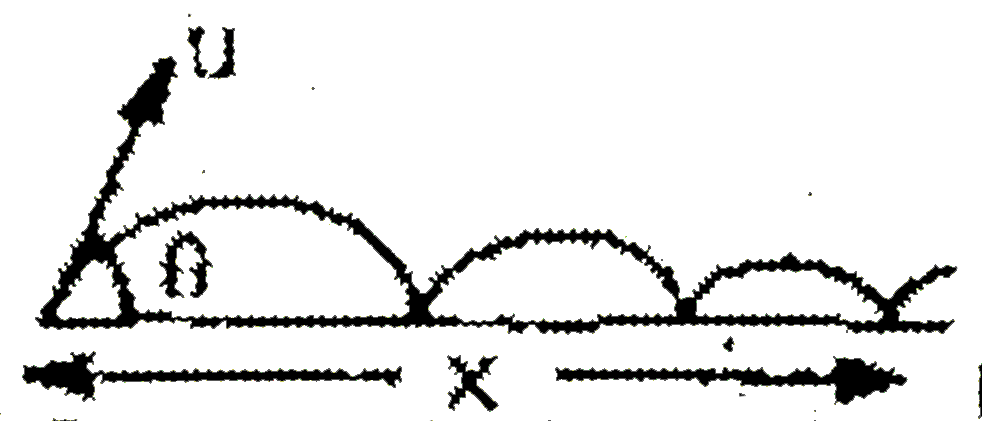A ball is projected from a point on a smooth horizontal floor at an angle θ with the horizontal . Speed of projection is u . Ball collides with the floor several times . Find the total time and horizontal distance covered by the ball .
To solve the problem of a ball projected at an angle θ with an initial speed u on a smooth horizontal floor, we need to find the total time of flight and the total horizontal distance covered by the ball after several collisions with the floor.
Step 1: Determine the time of flight for the first projectile motion
The time of flight for the first projectile motion can be calculated using the formula:
T1=2usinθg
where g is the acceleration due to gravity.
Step 2: Calculate the horizontal range for the first projectile motion
The horizontal range R1 for the first projectile motion can be calculated using the formula:
R1=u2sin2θg
Step 3: Analyze the collisions and subsequent motions
After the first collision, the ball will rebound with a reduced vertical speed due to the coefficient of restitution e. The vertical component of the velocity after the first collision will be:
v=e⋅usinθ
The angle of projection for the subsequent motion will be the same, but the vertical speed will be reduced.
Step 4: Calculate the time of flight for subsequent motions
For the second projectile motion, the time of flight T2 can be calculated as:
T2=2vsinθg=2(e⋅usinθ)g=2eusinθg
Step 5: Calculate the horizontal range for subsequent motions
The horizontal range R2 for the second projectile motion will be:
R2=v2sin2θg=(e⋅usinθ)2sin2θg=e2u2sin2θg
Step 6: Generalize for all subsequent motions
The time of flight and horizontal range will continue to decrease by a factor of e for each subsequent collision:
- Total time of flight:
Ttotal=T1+T2+T3+…=T1(1+e+e2+…)=T111−e=2usinθg(1−e)
- Total horizontal distance:
Rtotal=R1+R2+R3+…=R1(1+e+e2+…)=R111−e=u2sin2θg(1−e)
Final Results
Thus, the total time of flight and the total horizontal distance covered by the ball are:
Ttotal=2usinθg(1−e)
Rtotal=u2sin2θg(1−e)
The time of flight for the first projectile motion can be calculated using the formula:
T1=2usinθg
where g is the acceleration due to gravity.
The horizontal range R1 for the first projectile motion can be calculated using the formula:
R1=u2sin2θg
After the first collision, the ball will rebound with a reduced vertical speed due to the coefficient of restitution e. The vertical component of the velocity after the first collision will be:
v=e⋅usinθ
The angle of projection for the subsequent motion will be the same, but the vertical speed will be reduced.
For the second projectile motion, the time of flight T2 can be calculated as:
T2=2vsinθg=2(e⋅usinθ)g=2eusinθg
The horizontal range R2 for the second projectile motion will be:
R2=v2sin2θg=(e⋅usinθ)2sin2θg=e2u2sin2θg
The time of flight and horizontal range will continue to decrease by a factor of e for each subsequent collision:
- Total time of flight:
Ttotal=T1+T2+T3+…=T1(1+e+e2+…)=T111−e=2usinθg(1−e)
Rtotal=R1+R2+R3+…=R1(1+e+e2+…)=R111−e=u2sin2θg(1−e)
Thus, the total time of flight and the total horizontal distance covered by the ball are:
Ttotal=2usinθg(1−e)
Rtotal=u2sin2θg(1−e)
Topper's Solved these Questions
- WORK, ENERGY AND POWER Book:MODERN PUBLICATIONChapter:WORK, ENERGY AND POWER Exercise:NCERT FILE (NCERT Textbook Exercise)
Explore 23 Videos
- WORK, ENERGY AND POWER Book:MODERN PUBLICATIONChapter:WORK, ENERGY AND POWER Exercise:NCERT FILE (NCERT Additional Exercise)
Explore 7 Videos
- WORK, ENERGY AND POWER Book:MODERN PUBLICATIONChapter:WORK, ENERGY AND POWER Exercise:Conceptual Questions
Explore 20 Videos
- WAVESBook:MODERN PUBLICATIONChapter:WAVESExercise:CHAPTER PRACTICE TEST
Explore 14 Videos
Similar Questions
A ball is projected form a point A on a smooth inclined plane which makes an angle a to the horizontal. The velocity of projection makes an angle θ with the plane upwards. If on the second bounce the ball is moving perpendicular to the plane, find e in terms of α and θ. Here e is the coefficient of restitution between the ball and the plane.
View SolutionA ball is projected with velocity (u) at an anle α with horizontal plane. What is its speed when it makes an angle θ whith the horizontal plane ?
View Solution
Knowledge Check
A ball is projected from a point in a horizontal plane with a velocity of 20 m/s at 30∘ with the horizontal. Coefficient of restitution is 0.8, then
Aduration for which ball will rebound is 20 sBduration for which ball will rebound is 10 sChorizontal component of velocity of the ball is 17.3 m/s.Dhorizontal distance before the ball ceases to rebound is 173 mA ball of mass m is projected with a velocity 'u' at angle θ with the horizontal. It collides with a smooth box of mass 'M' at its highest position. If the co-efficient of restitution is 'e'.

Find the horizontal distance travelled by the ball before collision.Au22sinθcosθgBu2sinθcosθgCu2sinθcosθ2gDu2sinθcosθ4gA ball is projected with initial velocity u at an angle θ to the horizontal. Then horizontal displacement covered by ball as it collides third time to the ground would be, if coefficient of restitution is e :
 A(1+e)u2sin2θgBeu2sin2θgC(1−e)u2sin2θgD(1+e+e2)u2sin2θg
A(1+e)u2sin2θgBeu2sin2θgC(1−e)u2sin2θgD(1+e+e2)u2sin2θg
A particle is projected horizontal with a speed u from the top of plane inclined at an angle θ with the horizontal. How far from the point of projection will the particle strike the plane?
View SolutionA ball is projected from top of the table with initial speed u at an angle of inclination θ, motion of image of ball w.r.t ball

View SolutionA ball strikes a smooth horizontal floor obliquely and rebounds inelastically.
View SolutionA ball is projected horizontally with a speed v from the top of the plane inclined at an angle 45∘ with the horizontal. How far from the point of projection will the ball strikes the plane?
View SolutionA ball is projected from the ground at angle θ with the horizontal. After 1s, it is moving at angle 45∘ with the horizontal and after 2s it is moving horizontally. What is the velocity of projection of the ball ?
View Solution